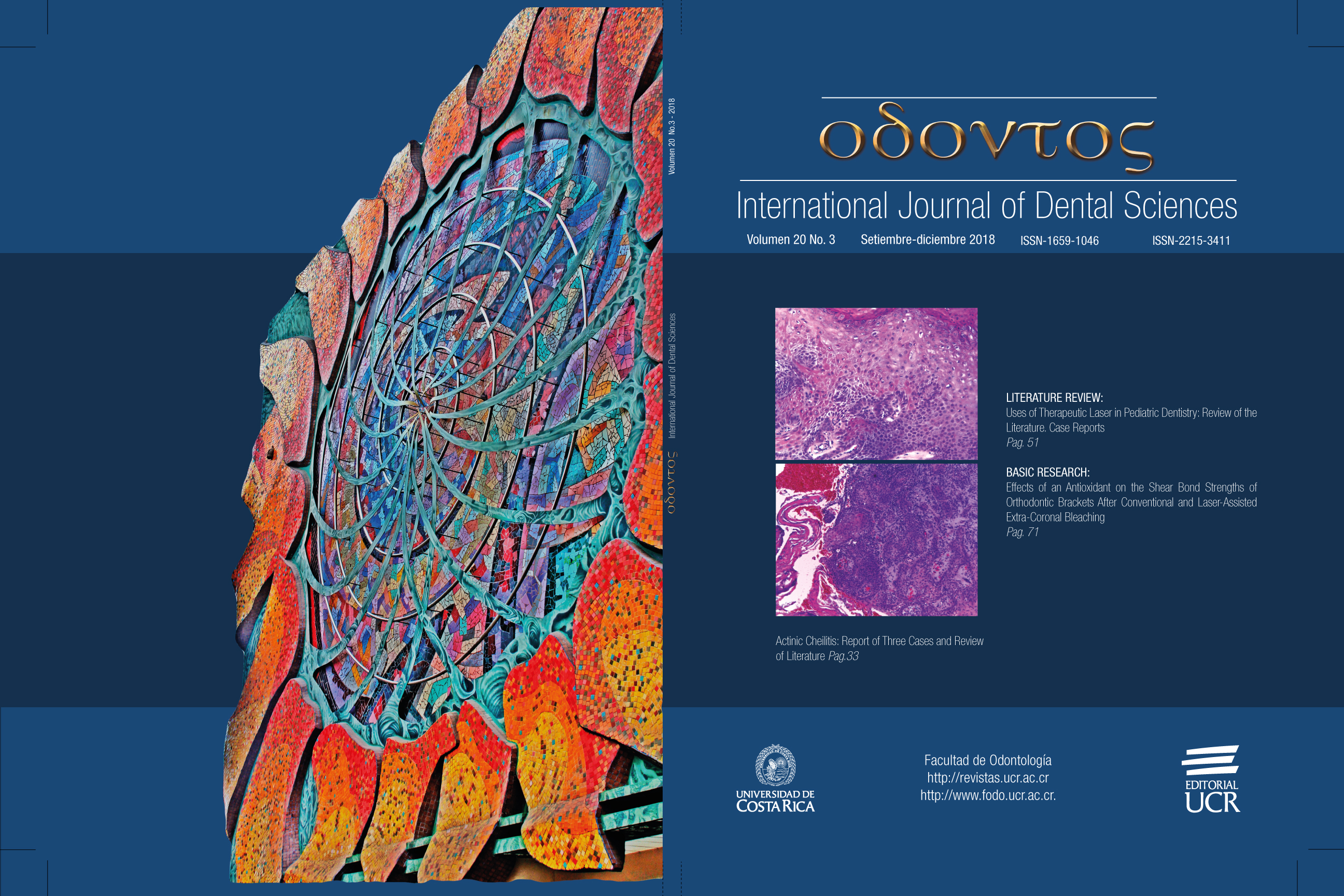Abstract
The objective of this study was to evaluate the compressive strength of a glass ionomer cement (GIC) under the influence of varnish protection and dietary fluids. Eighty cylindrical test specimens were made from GIC and distributed into four groups (G1, G2, G3, G4) according to the dietary fluid. Each group was further divided into subgroups A and B according to the presence or absence of varnish protection. The eight subgroup samples were stored in distilled water for 30 days and received the following treatments for 14 days: G2A: varnish protection and immersion in soft drink, G2B: no varnish protection and immersion in soft drink, G3A: varnish protection and immersion in orange juice, G3B: no varnish protection and immersion in orange juice, G4A: varnish protection and immersion in yogurt, G4B: no varnish protection and immersion in yogurt. The immersion procedure was performed three times a day, for 15 minutes at a time, for a total of 14 days. The samples from subgroups G1A (with varnish) and G1B (without varnish) were used as controls and stored in distilled water only for 30 days. The samples were submitted to a compressive strength test after the immersion period. The results were analyzed using the ANOVA 2, Tukey test (5%) and Student’s t-test (5%). There were no significant differences between the subgroups, except for the subgroup with varnish protection and immersion in orange juice, which showed reduced GIC compressive strength.
References
Paganelli, A. P. D., Constance, H. M., Sala, F. S., Bainha, C. C., Borges, A. L. S. Jr., Bastos, J. L., Peres, M. A. Trends in dental caries rates over 45 years (1971-2016) among schoolchildren in Florianópolis, southern Brazil. Int. Dent. J. 2017; 68 (1): 47-53.
Shintome L. K., Nagayassu M. P., Di Nicoló R., Myaki S. I. Microhardness of glass ionomer cements indicated for the ART technique according to surface protection treatment and storage time. Braz. Oral Res. 2009; 23 (4): 439-445.
Frencker, J. E. Atraumatic restorative treatment and minimal intervention dentistry. Br Dent J. 2017; 223 (3): 183-189.
Ferreira F. M., Vale M. P. P., Jansen W. C., Paiva S. M., Pordeus I. A. Performance of Brazilian and imported glass ionomer cements used in Atraumatic Restorative Treatment (ART) regarding microleakage in primary molars. J. Appl. Oral Sci. 2006; 14 (5): 312-318.
Hafshejani T. M., Zamanian A., Venugopal J. R., Rezvani Z., Sefat F., Saeb M. R., Vahabi H., Zarrintaj P., Mozafari M. Antibacterial glass-ionomer cement restorative materials: a critical review on the current status of extended release formulations. J Control Release. 2017; 262: 317-328.
De Moor R. J. G., Martens, L. C., Verbeeck R. M. H. Effect of a neutral citrate solution on the fluoride release of conventional restorative glass ionomer cements. Dent Mater. 2005; 21 (4): 318-323.
Lima A. L., Valença A. M. G., LIMA S. J. G., Alexandria A. K. F., Claudino L. V., Silva N. B. Estudo in vitro da ação da água de coco e caldo de cana sobre a superfície de restaurações estéticas. Pesq Bras Odontoped Clin Integr. 2007; 7 (1): 43-50.
Kucukyilmaz E., Savas S., Kavrik F., Yasa B., Botsali M. S. Fluoride release/recharging ability and bond strength of glass ionomer cements to sound and caries affected dentin. Nigerian J Clin Practice. 2017; 20 (2): 226-234.
França T. R. T., Sedycias M., Silva R. J., Beatrice L. C. S., Silva C. H. V. Use of glass ionomer cements: a systematic review. Pesq Bras Odontoped Clin Integr. 2010; 20 (2): 301-307.
Fragnan L. N., Bonini G. A., Politano G. T., Camargo L. B., Imparato J. C. P., Raggio D. P. Knoop hardness of three glass ionome cements. Pesq Bras Odontoped Clin Integr. 2011; 11 (1): 73-76.
Towler M. R., Bushby A. J., Billington R. W., Hill R. G. A preliminary comparison of the mechanical properties of chemically cured and ultrasonically cured glass ionomer cements, using nano-indentation techniques. Biomat. 2001; 22 (11): 1401-1406.
Yap A. U. J., Mah M. K. S., Lye C. P. H., Loh P. L. Influence of dietary simulating solvents on the hardness of provisional restorative materials. Dent Mater. 2004; 20 (4): 370-376.
Yip H. K., To W. M. An FTIR study of the effects of artificial saliva on the physical characteristics of the glass ionomer cements used for art. Dent Mater. 2005; 21 (8): 695-703.
Leite T. M., Bohaienko L. A., Luciano M., Pilllati G. L., Pereira S. K. Influência de substâncias com pH ácido sobre a microdureza de resinas compostas. Stomatos. 2010; 16 (30): 21-32.
American Nacional Standard Institute. American Dental Association. Specification nº 96. Dental water-basedcementes, 1994.
Wang L., Cefaly D. F. G., Santos J. L., Santos J. R., Lauris J. R. P., Mondelli R. F. L., Atta M. T. In vitro interactions between lactic acid solution and art glass-ionomer cements. J. Appl. Oral Sci. 2009; 17 (4): 274-279.
Hengtrakool C., Kukiattrakoon B., Kedjarune-Leggat U. Effect of naturally acidic agents on microhardness and surface micromorphology of restorative materials. Eur J Dent. 2011; 5 (1): 89-100.
Khoroushi M., Keshani F. A review of glass-ionomers: From conventional glass-ionomer to bioactive glass-ionomer. Dent Res J. 2013; 10 (4): 411-420.
Braga S. R. M., Garone N. Neto, Soler J. M. P., Sobral M. A. P. Degradação dos materiais restauradores utilizados em lesões cervicais não cariosas. Rev Gaúcha Odontol. 2010; 58 (4): 431-436.
Felemban N. H., Ebrahim M. Effects of adding silica particles on certain properties of resin-modified glass-ionomer cement. Eur J Dent. 2016; 10 (2): 225-229.
Kanik O., Turkun L. S., Dasch W. In vitro abrasion of resin-coated highly viscous glass ionomer cements: a confocal laser scanning microscopy study. Clin Oral Investig. 2017; 21 (3): 821-829.
Pilo R., Ben-Amar A., Barnea A., Blasbalg Y., Levartovsky S. The effect of resin coating on the shear punch strength of restorative glass ionomer cements. Clin Oral Invest. 2017; 21 (4): 1079-1086.
